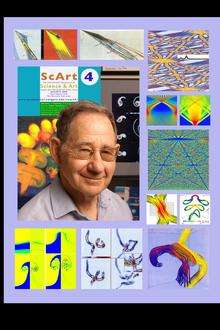Norman Zabusky
| Norman J. Zabusky | |
|---|---|
 Norman Zabusky with images and space-time diagrams (2005) | |
| Born |
January 4, 1929 (age 87) Brooklyn, New York City, New York |
| Residence | Rehovot, Israel |
| Citizenship | United States |
| Nationality | United States |
| Fields | Fluid dynamics and Waves; Computational fluid dynamics |
| Institutions |
Weizmann Institute of Science , Rutgers University, New Jersey, USA, Emeritus |
| Alma mater |
City College of New York Massachusetts Institute of Technology California Institute of Technology |
| Doctoral advisor | Milton S. Plesset and Leverett Davis |
| Known for | Theory and simulation of solitons; visiometrics |
| Notable awards |
2003: Otto Laporte Award of the American Physical Society, Division of Fluid Dynamics, "For pioneering and enduring contributions in nonlinear and vortex physics and computational fluid dynamics, including: the soliton; contour dynamics and V-states for 2D flows; vortex projectiles for accelerated inhomogeneous flows; and visiometrics for reduced modeling.” |
Norman J. Zabusky is an American physicist, who is noted for the discovery of the soliton in the Korteweg–de Vries equation, in work completed with Martin Kruskal. This result early in his career was followed by an extensive body of work in computational fluid dynamics, which led him more recently to an examination of the importance of visualization in this field. In fact, he coined the term visiometrics to describe the process of using computer-aided visualization to guide one towards quantitative results.
Biography
He was born in Brooklyn, New York City on January 4, 1929 to Hyman Zabusky. He attended the City College of New York, where he received a Bachelor's degree in electrical engineering in 1951, after which he went to the Massachusetts Institute of Technology, receiving his Master's degree in electrical engineering in 1953. After two years, Zabusky decided to leave engineering and pursued a Ph.D. in theoretical physics at the California Institute of Technology, which he received in 1959 with a thesis in the area of stability of flowing magnetized plasmas.
In 1965, Zabusky and Kruskal pioneered the use of computer simulations to gain analytical insights into non-linear equations, and in the process, discovered the soliton solutions to the Korteweg–de Vries equation. The study of non-linear equations was enhanced by this discovery, opening up the door to analytical work on the integrability of the KdV equation and the equations of the KP hierarchy. But perhaps more important was the methodology. The use of computer simulations led Zabusky to an appreciation of the importance of appropriate visualization and quantification as a tool in analyzing fluid dynamical and wave systems.In 1990, he and Francois Bitz introduced the term visiometrics as described in the reference below.
Zabusky worked at Bell Laboratories from 1961 to 1976, after which he joined the faculty of the University of Pittsburgh as a Professor of Mathematics. In 1988, he left Pittsburgh to become the State of New Jersey Professor of Computational Fluid Dynamics in the Rutgers University in the Department of Mechanical and Aerospace Engineering. After receiving the Jacobs Chair in Applied Physics (2000–2005) at Rutgers University he became interested in science and art and organized the 4th International Symposium, ScArt4. He retired from Rutgers as Emeritus Professor in 2006 and has been visiting the Dept. of Physics of Complex Systems at the Weizmann Institute of Science.